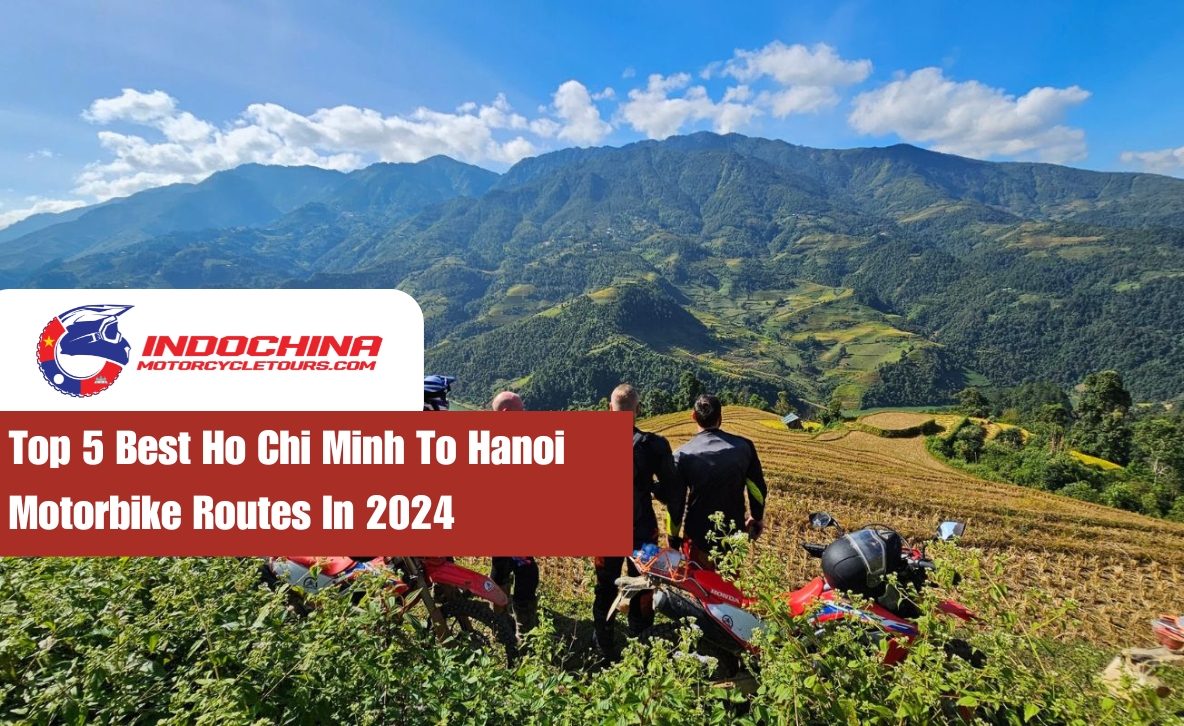Vietnam is a peaceful country with thousands of breathtaking sceneries attracting countless tourists yearly. However, there are multi-lane roads in some places and lots of transportation options, which may be confusing, especially for foreign visitors. Therefore, to ensure safety while enjoying this beautiful country, adhering to its traffic regulations is crucial. Let’s discover the traffic rules in Vietnam through this article to have an enjoyable trip.
Traffic Regulations in Vietnam
Whether you’re a local resident or a foreign visitor, adhering to traffic rules in Vietnam is essential, especially during motorcycle tours in Vietnam. Following traffic safety standards not only ensures smoother vehicle flow but also enhances driver safety, making it easier to reach your destination efficiently.
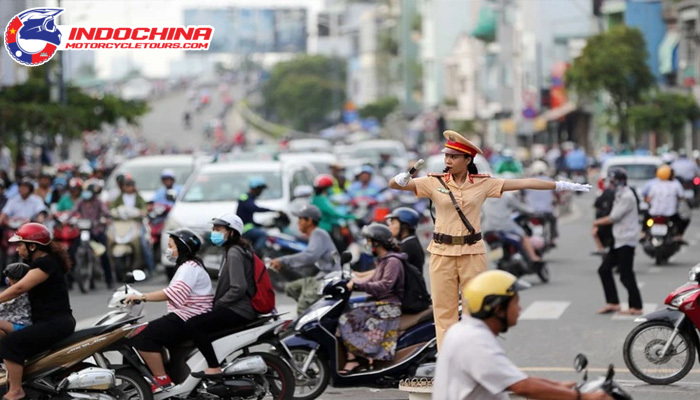
Traffic Rules in Vietnam: Ensuring Safety for All
1. Overview of Traffic Rules
Admittedly, Vietnam’s transportation system is quite complicated, from the road to the traffic, and it sometimes makes foreign people afraid to cross the street. These laws cover a variety of aspects, including priority regulations, speed limits, lane discipline, and obedience to traffic signals and signage. Drivers must follow traffic rules, such as yielding to pedestrians at authorized crossings and maintaining the right of way.
Traffic police enforce these laws and impose penalties for infractions to guarantee compliance and keep the roadways safe. Overall, following traffic rules is critical to guaranteeing road safety and reducing accidents, contributing to the smooth flow of traffic and the well-being of all users on Vietnamese roads.
2. Understanding Pedestrian Crossings
Understanding pedestrian crossings is critical for all road users, contributing to a safer traffic environment for both pedestrians and drivers. During Hanoi motorbike city tours, when drivers clearly understand pedestrian crossings, they can easily recognize and give way to pedestrians, minimizing the risk of collisions and ensuring a safer and more enjoyable experience for everyone on the road.
Specifically, when seeing a light signaling pedestrians to cross the street, the rider must stop and wait until the signal ends. Drivers must pay attention to the road, slow down, and give way to pedestrians, elderly, and disabled people crossing the road.
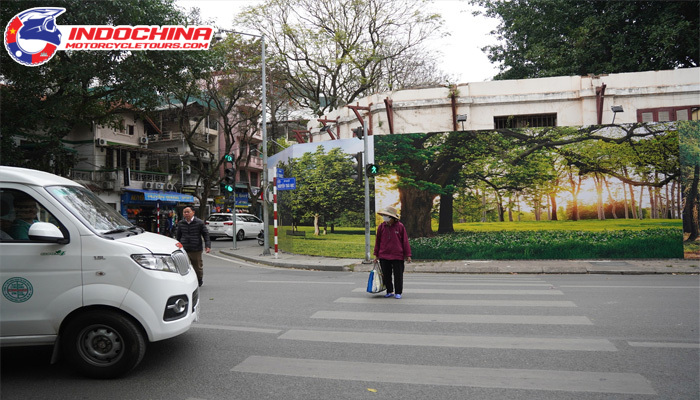
Understanding Pedestrian Crossings: Traffic Rules in Vietnam
3. Key Aspects of Road Safety
For foreign tourists traveling to Vietnam for the first time, keep in mind the following main aspects of the road to ensure safety:
- Speed limits: Drivers are not permitted to drive more than 40km/h in urban areas and 60km/h on highways and rural roads.
- Priorities: Give way to the ambulance. If coming across huge vehicles like buses or trucks, let them go first to avoid confusion and potential accidents.
- Lanes: In Vietnam, vehicles will stay on the right side of the road to reduce collisions.
- Motorcycle helmet: Using a helmet to protect your head is mandatory in traffic rules in Vietnam.
- Drunk driving is forbidden: Driving after drinking any amount of alcohol is strictly prohibited. Even one glass of beer can lead to unpredictable and dangerous consequences.
- Avoid using mobile phones while driving: Talking on the phone while driving will distract you and easily lead to an accident.
- Number of people: A motorcycle should carry a maximum of two people, except in instances such as carrying ill individuals to the hospital, escorting people who have violated the law; children under 14 years old, and elderly or disabled people.
Read more: Vietnam Motorbike Routes: Must-Ride Paths for Every Traveler
4 Essential Traffic Rules in Vietnam Tips for Safety in Traffic and on the Road
Here are some essential guidelines for travelers embarking on a Moc Chau Plateau motor tour to ensure a comfortable and safe journey:
- Obey Traffic Rules: First and foremost, always follow traffic rules in Vietnam such as speed limits, signs, and signals to ensure safety.
- Keep a safe distance: Make sure to keep a safe distance from other vehicles, helping to avoid rear or front collisions.
- Pay Attention to Road Conditions: Always adjust your speed and respond quickly to changing road conditions, such as rain, slick roads, or poor light.
- Increase traffic awareness: Take safe driving classes or participate in traffic safety education initiatives.
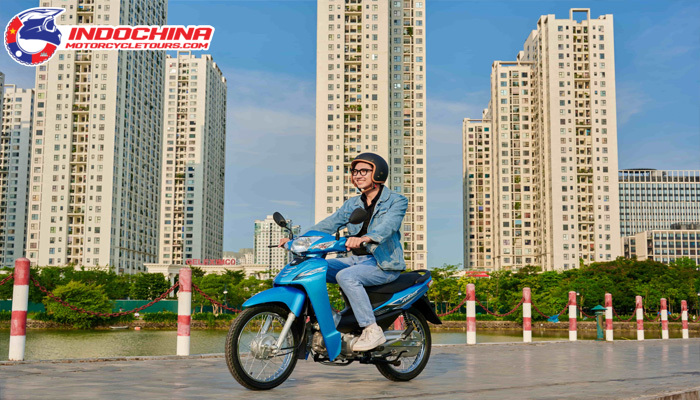
Traffic Rules in Vietnam: Safe Motorbike Riding in Urban Areas
Navigating Pedestrian Crossings in Vietnam
In case a tourist wants to cross the street but is hesitant because hundreds of cars are constantly moving, let’s consider the following tips:
1. Safe Crossing Practices
Make eye contact with oncoming traffic and indicate with your hands before crossing the street. Additionally, foreign tourists can also cross the street by following the locals to get to the other side of the street. Another option is to hold off until a big car turns to cross the road.
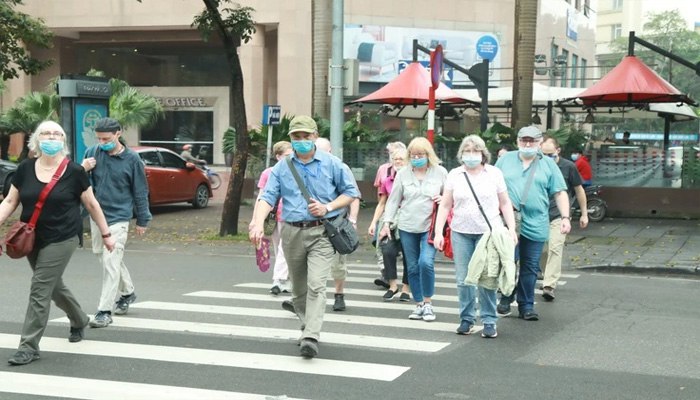
Traffic Rules in Vietnam: Pedestrian Safety and Crosswalk Etiquette
2. Pedestrian Traffic Signals
Cross the street at the pedestrian traffic signal or at a crosswalk. Take advantage of traffic stops to cross the street safely. However, most pedestrian signals will be effective for 30 seconds, make sure you cross the street quickly when the light is on.
3. Awareness of Surroundings
In addition to crossing the street based on the signal light or looking around to get to the other side. If you want to cross the street in high traffic or in dimly lit locations, be sure the motorist sees you, then raise your hand to signal so that they slow down and yield to you. If there aren’t many automobiles in the vicinity, you can simply cross the street on foot.
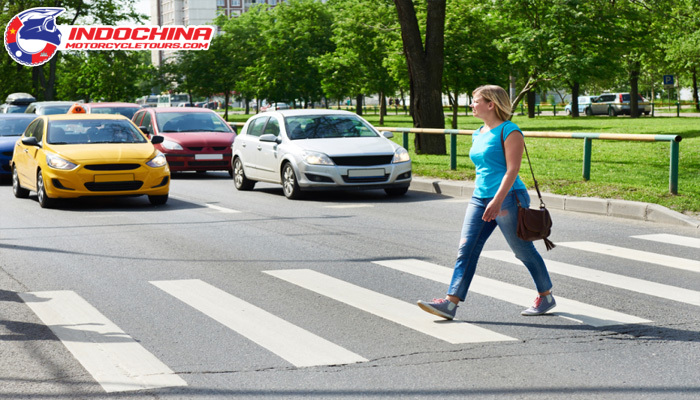
Ensuring Road Safety in Vietnam
To maintain as safest as possible in traffic in Vietnam, road users must also take the following precautions to avoid unfortunate problems:
1. Vehicle Maintenance
In Northeast Vietnam Motorcycle Tours, ensuring vehicle maintenance is paramount for ensuring road traffic safety. Well-maintained motorcycles are less susceptible to mechanical issues, reducing the risk of traffic accidents. Routine checks on brakes, lights, tires, and engine performance are essential to detect and address potential problems before they pose safety threats.
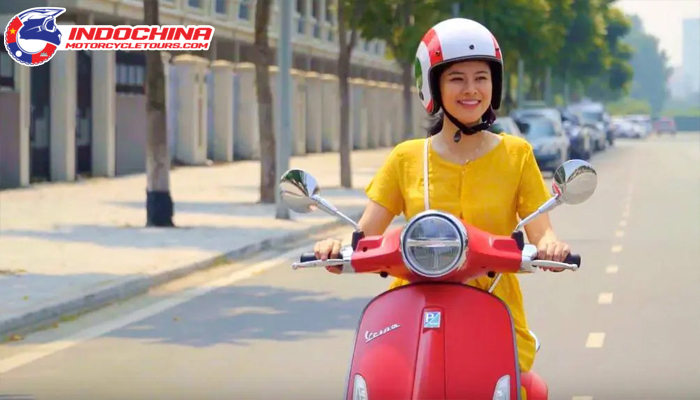
2. Defensive Driving Techniques
Traffic laws in Vietnam require participants to have standard driving techniques to ensure safety. By taking proactive measures such as keeping a safe distance, anticipating other drivers’ movements, and staying alert, drivers can reduce the risk of accidents on the road. It involves a safety-first mindset and being prepared to respond to unexpected situations.
3. Emergency Preparedness
Emergency readiness is an important component of guaranteeing road safety in Vietnam, including being prepared to deal with unforeseen situations or accidents that may arise when engaging in traffic in Vietnam. This includes a basic understanding of first aid techniques, and knowing how to deal with different types of emergencies such as vehicle breakdowns, collisions, or medical emergencies.
Additionally, having emergency contact numbers and nearby hospitals or medical facilities can be essential in critical situations.
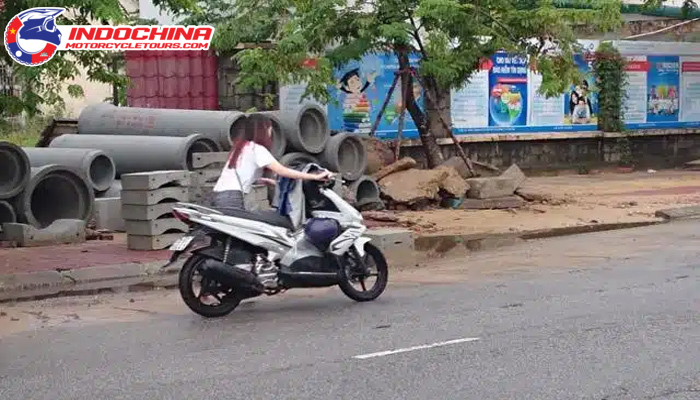
Guidelines for Safety on Roads and in Traffic in Vietnam
Even though Vietnam is an attractive country to visit owing to its safety and plenty of gorgeous places, travelers may encounter challenging traffic in Vietnam. Here are some guidelines that will help you have a safe trip:
1. Use of Safety Gear
It is compulsory to wear a safety helmet while riding. Make sure you have a well-fitting headgear that adheres to traffic rules in Vietnam to keep you safe in case of mishaps.
Drivers who do not wear safety gear while driving may face administrative fines under road traffic regulations. The fines range from 400,000 to 600,000 VND.
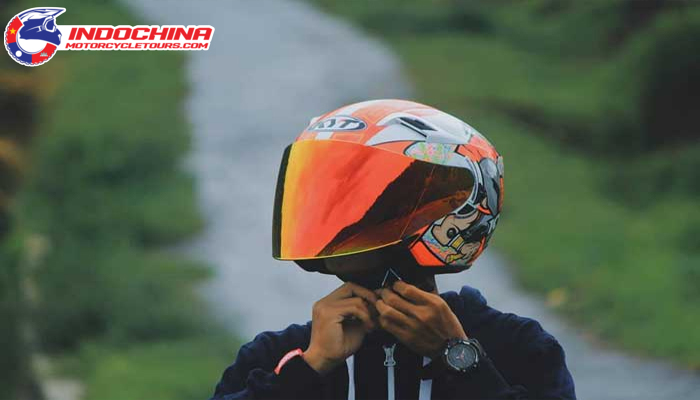
2. Handling Intersections
Roads in Vietnam feature multiple intersections, therefore if you need to cross one, always express your intention with a turn signal, maintain a clear direction and position on the road, and only move when it’s definitely safe. However, do not operate too suddenly as it will threaten the adjacent traffic flow and the opposing side. Furthermore, be alert and never assume that a vehicle with its turn signal on is always heading in the correct direction.
3. Importance of Communication on the Road
It cannot be denied that communicating while driving is critical, especially when traveling in a country with a complex traffic system such as Vietnam. Drivers can communicate with others using turn signals, horns, and hand gestures to indicate intentions, warn others of possible hazards, and express thanks or apologies.
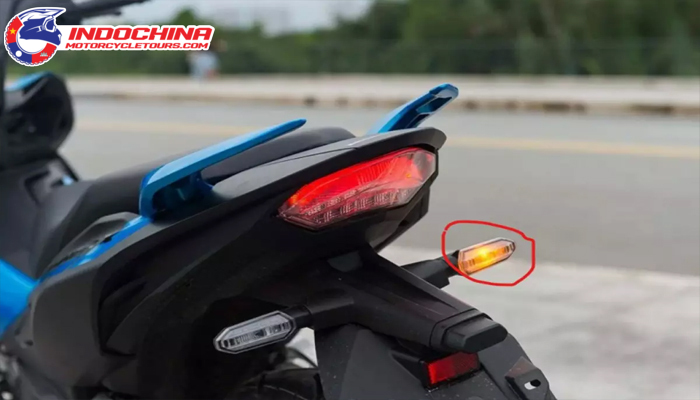
Focus of Traffic Safety Year 2024: Addressing Drink Driving and Speeding Offenses
In 2024, Vietnam will pay more attention to and handle cases of violations of drinking and driving, as well as speeding. To prevent undesirable penalties, traffic participants ought to keep in mind the following:
1. Campaign Against Drink Driving
Using alcohol while participating in traffic is a violation of the law in Vietnam. There have been many cases of violation and irreversible consequences not only for them but also for others.
According to Vietnam Traffic Law, the alcohol content limit is less than 50 mg/100 mL of blood or 0.25 mg/liter of breath. If violated, you will have to pay a very large punishment; in most situations, the cost will be between 2 million VND and 40 million VND if there is too much alcohol in the blood.
There will be no exemptions to this crime. As a result, drivers must remain vigilant and refrain from drinking alcohol while driving.
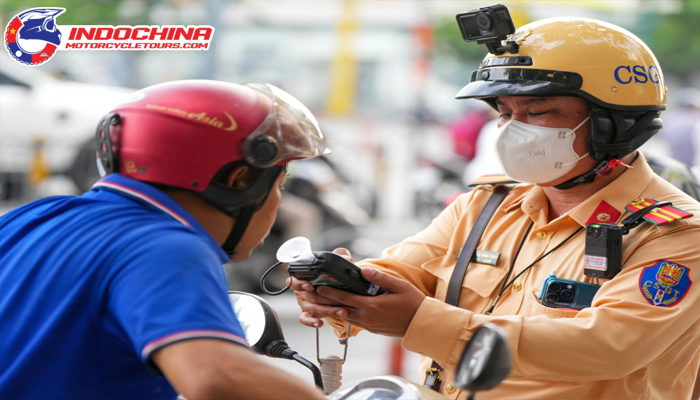
2. Crackdown on Speeding Violations
When driving in Vietnam, travelers must pay attention to their speed to avoid being fined for violates, particularly in 2024, when traffic regulations will be tightened. Driving a motorcycle exceeding the speed limit would result in a punishment of 400,000 to 5 million VND. Therefore, it is advisable to obey traffic rules and the speed restrictions on each road when driving.
3. Public Awareness and Education Initiatives
To maintain traffic order and safety, measures such as promoting education and guiding to increase public awareness when driving have been acquired. The importance is participants in traffic must adhere to traffic rules regarding the amount of time, speed, and space between vehicles in traffic. Therefore, to protect driver’s safety, there will be stricter traffic rules and tighter penalties in 2024 compared to prior years.
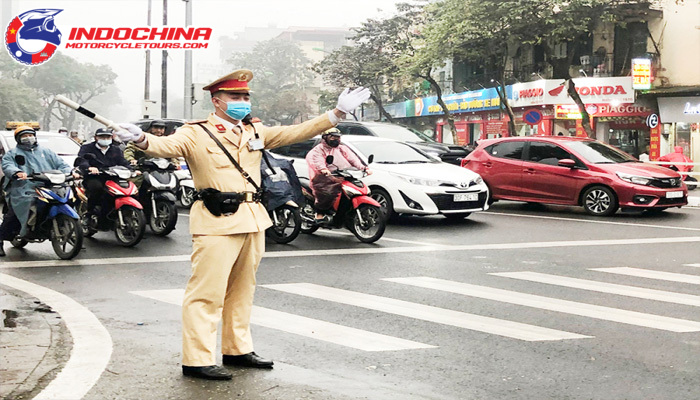
Traveling on a motorcycle is one of the most enjoyable experiences when visiting Vietnam. Visitors can admire the stunning natural landscape while also learning about cultural and artistic values, national identity, heroic history as well as the Vietnamese people. However, to make the best of your adventure, strict compliance with Vietnamese traffic rules is a must. This article has provided visitors with detailed information about the rules when participating in traffic in Vietnam to ensure their safety throughout the journey, from driving laws to crossing the road. Indochina Adventure Tours hopes that this information will give tourists the best moments of enjoyment in this beautiful country.
In the above article, Indochina Adventure Tours has helped you understand more about traffic rules in Vietnam to ensure safety when participating in traffic. If you find it difficult to grasp these rules, don’t worry. Let indochinamotorcycletours.com simplify your travel experience. Contact us via this website for advice!
Read more: Exploring Ha Noi to Cao Bang Motorbike Routes: Your Ultimate Guide



